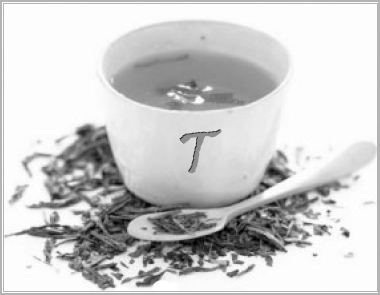
Tennis Elbow (Chronic)
WHAT IS IT AND WHAT CAUSES IT?
Tennis elbow is tendonitis. The main symptom is pain and tenderness on the inside or outside of the elbow. It is often caused by small tears in the tendons due to excessive, repeated movement or sudden twisting of the elbow.
WHEN SHOULD YOU SEE A DOCTOR?
If you have had pain for more than one week, see a doctor.
WHAT SHOULD YOU DO IN DAILY LIFE?
- Rest your arm for a while. Be patient and give it time to heal.
- Soaking your elbow in warm water for 10 minutes or applying a heating pad several times a day may help.
- Always keep your elbow warm. Cut a piece of thick fabric and sew this fabric on the sleeve of your clothes. Or cut large, old socks in half and wear on your elbow during your sleep. It must be loose to increase blood circulation.
- Walking 30 minutes daily, while naturally swinging your arms, may help.
- Try wearing an elbow brace.
WHAT SHOULDN'T YOU DO?
- Don't do prolonged, repeated bending or rotating of your elbow or forearm. Always warm up your arm and wrist by stretching and flexing them. Take breaks between the activities.
Folk Remedies
- Steam with chili pepper: Place some dehydrated small chili peppers in a metal container. Burn it outside your house. Place your arm over it to steam for 10 minutes, once a day.
- Apply ginger and onion:
Ingredients: 3 oz. prickly ash peels, 1/2 oz. fresh ginger, 6 white stalks of green onion.
Procedure: Slice ginger into small pieces. Place all ingredients in a cotton bag. Apply the bag to your elbow for 30 minutes with a heating pad on top, twice a day for seven days. If you have an allergic reaction, stop.
- Cut old and large socks in half to fit your arm and soak in vodka. Wear on your forearm and wrap with clear plastic wrap. It must be loose to increase blood circulation. Apply a heating pad on top. Wear for 30 minutes, once a day. If you have an allergic reaction stop.
Chinese Massage
Choose the following and massage once a day:
- Using your palm very gently knead and rub the muscles around your elbow for two minutes. Using your thumb or index finger, gently press and knead the painful spot and its edges for two minutes.
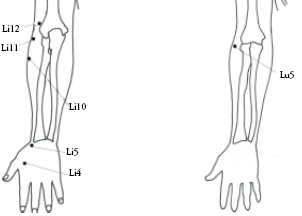
- Using the side of the palm on the little finger side, push the outside muscles of your upper arm down to the forearm and wrist for one minute. Using your palm, rub back and forth over the affected arm from the shoulder down to the wrist for one minute.
- Using your fingers and the heel of the palm, grasp your arm and massage from the shoulder to the wrist several times.
- Using your thumb, index, and middle fingers, grasp the following points for one minute:
- When your arm is folded across your chest, the point at the end of the crease on the top of the elbow joint (Li11).
- With your thumb against the index finger, the webbing where it bulges up the highest (Li4).
- Using your thumb, gently press and knead the following points for one minute, while bending and stretching your forearm:
- When the arm is folded across the chest, the point at the end of the crease on the top of the elbow joint (Li11).
- The point two thumb-widths down below Li11 point (Li10).
- The point one thumb's-width above Li11 (Li12).
- The point on the inside crease of the elbow in the depression on the outer edge of the tendon (Lu5).
- On the back of the hand in the depression, where the wrist crease meets the line from the thumb (Li5).
Chinese Herbs
- Apply a heating patch with herb, called Chinese Moxibustion. Follow the instructions.
- Apply the herb patch Shang Shi Zhi Tong Gao. If you have an allergic reaction, stop.
TMD (Temporomandibular Disorder)
WHAT IS IT AND WHAT CAUSES IT?
Temporomandibular disorder was formerly called “temporomandibular joint syndrome” (TMJ). The symptom is a painful jaw with difficulty chewing and talking. Emotional stress is the most common cause of TMD.
WHEN SHOULD YOU SEE A DOCTOR?
If you have persistent pain in your jaw, see a doctor.
WHAT SHOULD YOU DO IN DAILY LIFE?
- Rest your jaw as much as possible.
- Keep warm always.
- When you have an acute attack, apply ice for 15 minutes to relieve the pain and reduce the swelling, three times a day. In a chronic case, apply a heating pad to increase local blood circulation.
- Eat soft food.
- Reduce stress as much as you can.
WHAT SHOULDN'T YOU DO?
- Don't sleep on your stomach with your head twisted to one side. Don't read a book with your head propped up on a pillow at a sharp angle. Avoid activities that twist, bend, or raise your head for a prolonged period. Don't cradle the phone between your neck and shoulder. Don't carry a heavy bag on your shoulder.
- Don't open your mouth too wide while yawning.
- Don't chew gum. Avoid hard, crunchy food.
- Don't expose yourself to wind. Wear a mask or scarf in cold weather.
Chinese Massage
Choose the following and massage each point for one to two minutes, once a day:
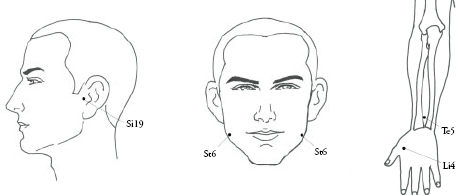
- Use the pad of your thumb to find the painful point on the lower jaw. Gently press and knead that point. Flick the muscles several times.
- Use your thumb to push from the indentation level with the top of the ear down to the lower jawbone.
- Use your thumb to gently press and knead the depression in front of the middle of the ear when the mouth is slightly open (Si19).
- Use your thumb to gently press and knead the point in the corner of the lower jawbone, in the high point formed by the muscles when the teeth are clenched (St6). Open and close your mouth while massaging this point.
- With your thumb against the index finger, use your other thumb to gently press and knead the webbing where it bulges up the highest (Li4).
- Gently press and knead the point two thumb-widths above the wrist in the depression between the bones on the back of the forearm (Te5).
Toothache
WHAT IS IT AND WHAT CAUSES IT?
Toothache is a commonly encountered problem. The main cause of toothache is tooth decay, which can lead to infection in the root of your tooth.
WHEN SHOULD YOU SEE A DOCTOR?
If you have a toothache, see your dentist.
WHAT SHOULD YOU DO IN DAILY LIFE?
- Rinse vigorously with a mouthful of warm, salty water. Or swish your mouth with liquor, but don't drink the alcohol. Swish 3-percent hydrogen peroxide solution in your mouth for five seconds and spit out.
- Ice your cheek with a frozen vegetable bag or a reusable gel pack wrapped with thin cloth for 10 minutes. Apply a warm, wet black tea bag.
- Eat more pumpkins, watermelon, water chestnuts, celery, and daikon radish.
- Have regular bowel movements.
- Control your emotions, which may be a trigger for tooth pain.
- Use special toothpaste for sensitive teeth.
- Be aware that trigeminal neuralgia and temporomandibular disorder will cause tooth pain.
WHAT SHOULDN'T YOU DO?
- Don't eat food that is too cold, too hot, or too sour. Don't eat spicy food such as onions, mustard, and chili peppers.
Folk Remedies
- Chewing soaked green tea leaves may give some relief.
- Rinse your mouth with vinegar and prickly ash peels:
Ingredients: 60 ml rice vinegar, 60 ml water, 1 oz. prickly ash peels.
Procedure: Boil ingredients in a pot on low heat for 10 minutes. Wait until it cools. Rinse your mouth for two minutes and spit out. Then wash your mouth with warm water. Don't swallow.
Food Therapy
- Drink tofu soup with olives:
Ingredients: 4 salty olives, 1 lb. tofu.
Procedure: Add 2 cups of water to make soup. Eat once a day.
Chinese Massage
In general, choose the following to get some relief.
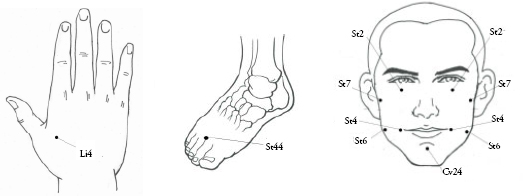
- With your thumb against the index finger, use your hand to pinch the webbing where it bulges up the highest (Li4). If the painful tooth is on the left, pinch the opposite hand. Vice versa.
- Press and knead the point on the base of toes between the second toe and the third toe (St44).
Specially for an upper tooth:
- Gently press and knead the depression in front of the ear while the mouth is closed (St7). The depression disappears when the mouth is open.
- Using both index fingers, gently press the point one finger's-width right below the eye socket in line with the pupil (St2).
Specially for a lower tooth:
- Using your thumb, gently press the point in the corner of the lower jawbone, in the high point formed by the muscles when the teeth are clenched (St6).
- Using both index fingers, gently press and knead the points at the corners of the mouth as it is closed (St4). Gently press and knead the depression in the center of the groove between the chin and lower lip (Cv24).
Chinese Herbs
- Spread the patent herb powder Yun Nan Bai Yao on the painful spot. Follow the instructions.
Trigeminal Neuralgia
WHAT IS IT AND WHAT CAUSES IT?
Trigeminal nerves convey sensory information from the face to the brain. A disruption of their functions, such as pressure from a blood vessel, can cause the brief but excruciating, stabbing pain on one side of the face, which is the symptom of trigeminal neuralgia.
WHEN SHOULD YOU SEE A DOCTOR?
If you have persistent face pain and no sign of improvement, see a doctor.
WHAT SHOULD YOU DO IN DAILY LIFE?
- When you have pain, soak your feet in warm water at a temperature you can tolerate. Meanwhile, massage the sole of your foot and the area around the anklebone. Soaking your feet in warm water frequently can reduce the chance of an attack.
- When you are washing your face, brushing your teeth, or eating, do so very gently. Sometimes, daily activities such as brushing your teeth can trigger an episode. Don't use water that is too hot or too cold.
WHAT SHOULDN'T YOU DO?
- Don't eat spicy or greasy food, hot pepper, curry, ginger powder, or mustard. Eat soft food only. Avoid crab, shrimp, and other seafood, fried foods and nuts.
- Don't drink alcohol or coffee. Do not consume food or liquids that are too hot.
- Don't smoke. Nicotine will contract the blood vessels and trigger the pain.
- Don't expose yourself to wind. Wear a scarf over your face in cold weather.
- Limit stress both mentally and physically. Stress may be the most common trigger.
Folk Remedies
- Comb your head with a wooden comb: Comb from your forehead to the top then down the back of your head 20 times per minute. You can increase the speed gradually. Comb evenly with adequate force, but not too hard to damage your skin. Comb for five minutes every time. Repeat this procedure three times a day for one month. This procedure is good for first branch nerve pain.
- Drop radish juice in the nose. Use a juicer to make red radish juice. Lie down on your back. Use an eyedropper and apply two drops in the nostril on the side of the facial pain.
Food Therapy
- Drink sunflower petal tea:
Ingredients: 4 oz. sunflower petal (dried, without seeds), 2 Tbs. sugar.
Procedure: Wash the petal clean. Cut into small pieces and put in a pot with 4 cups of water. Bring to a boil. Reduce heat and simmer for 15 minutes. Strain the decoction into a container. Then start a second batch. Add 2 cups of water into the pot and follow the above instructions to make another decoction. Mix the two decoctions together. Drink 100 ml one hour after meals, twice a day for five days. Keep unused decoction in a refrigerator.
Chinese Massage
Choose the following and massage once a day:
- Rub both palms against each other until they feel warm. Place them on your face and rub gently up and down 30 times. Don't touch the area that triggers the pain.
- Gently press and knead the temples with your fingers until you have a sensation of soreness and distention.
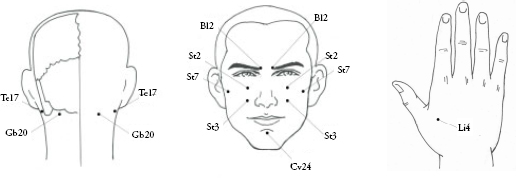
- Gently press and knead the point in the depression at the bottom of the skull, outside of the two big muscles on the neck, which you can feel by bending down your neck for two minutes (Gb20).
- Use your thumb to gently press the depression in front of the ear while the mouth is closed (St7). The depression disappears when the mouth is open. At the same time, use your index fingers to gently press the depression directly behind the earlobe (Te17). Gently press these points simultaneously for one minute.
- With your thumb against the index finger, use your other thumb to gently press and knead the webbing where it bulges up the highest (Li4).
- If you have forehead pain, gently press and knead the point in the depression on the beginning of the eyebrow for one minute (Bl2).
- If you have pain from the upper jaw, gently press and knead the following points for one minute:
- The point one finger's-width right below the eye socket, in line with the pupil (St2).
- The point on the cheek directly under the eye pupil and level with the low edge of the nostril (St3).
- If you have pain from the lower jaw, gently press and knead the following points for one minute:
- The depression in the center of the groove between the chin and lower lip (Cv24).
- The depression in front of the ear while the mouth is closed (St7). The depression disappears when the mouth is open.
Chinese Herbs
- Steam your face with herbs:
Ingredients: 1/4 oz. siler, 1/4 oz. notopterygium root, 1/4 oz. dang gui, 1/4 oz. ligusticum, 1/4 oz. batryticated silkworm.
Procedure: Add ingredients to 4 cups of water. Bring to a boil. Reduce heat and simmer for 20 minutes. Steam your face for 20 minutes, twice a day. Be careful not to scald your face.



